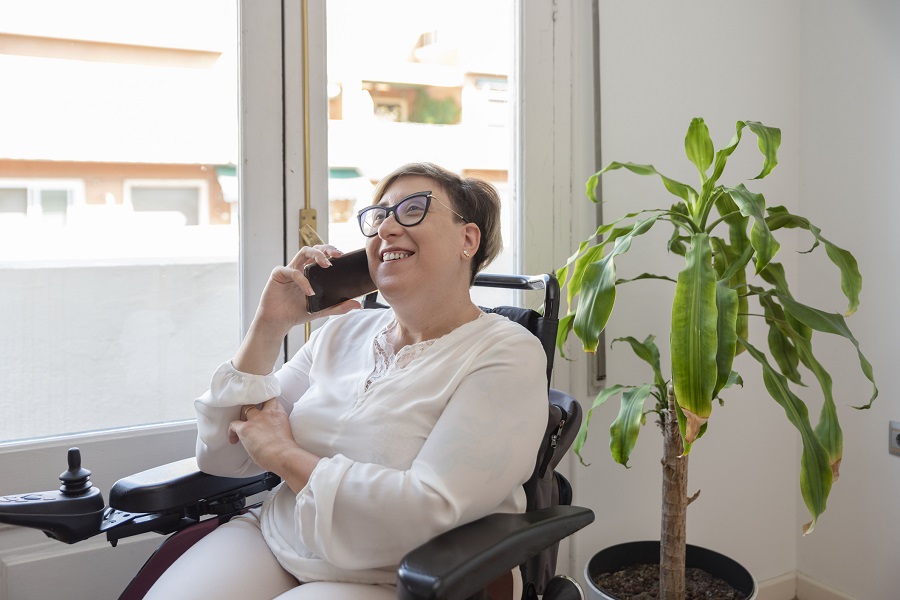State of Colorado Accessibility Newsletter - October 2024

Accessibility News
Check out the Lived Experiences Library!
By Kate Miller (she/her), TAP Accessibility Consultant
TAP’s Lived Experiences Library officially kicked off in September. The Lived Experiences Library will provide one-on-one, team and panel discussions to build understanding of accessibility, equity and diversity and lead to more inclusive and innovative digital technology. These discussions may include storytelling, user experience feedback and user demonstrations.
The Community Steering Committee (CSC) led initiative is designed to build a positive framework for conversations that can challenge stereotypes and prejudices through dialogue. The concept is based on The Human Library®, which is a global innovative and hands-on learning platform.
The goal of the Library is to create a productive framework for personal conversations that can help challenge bias, reduce discrimination, prevent inaccessible design choices and contribute to greater human connection.
Why engage with the Lived Experiences Library?
- Gain human-centered insight into the most important aspects of having accessible, equitable and inclusive digital products.
- Learn how accessibility barriers can make for a challenging experience for people interacting with your digital products, and what can be done about it to improve the user journey.
- Understand the importance of features and practices that allow for a seamless experience consuming or interacting with your digital products.
- Get real time feedback, witness user pain points and think about ways to address and implement best practices.
- The Library is an opportunity to work differently.
If you work for a state government agency or organization, you can engage with the Lived Experiences Library now! Start by filling out the intake form and we will reach out to you.
Accessibility Essentials
A Halloween blog: Hair-raising truths about the color red
By Francie Billings, Dept. of Revenue Digital Content Specialist
In the cauldron of colors, red has long been a nightmare for newcomers in the world of digital accessibility. Many designers fear that using red in a chart, graph or for alert banners will become a fright-fest for those impacted by color blindness. However, using the color red isn’t so scary and shouldn’t be feared.
Red-green color blindness is the most common variety of color vision deficiency. Most people diagnosed with color blindness cannot see the colors red or green in the same way as people with normal color perception, but the colors are not invisible to them. People who have red-green color blindness see those hues as more of a brown palette. This particular color vision deficiency is inherited and affects about 1 in 12 men and about 1 in 200 women.
In Western culture, red is meant to create strong emotions and evoke psychological thrills. Whether the message is suspenseful, sensual or spooky, red is often used in design to draw attention. It is a paradox that red is often used to convey important meaning, when the bone-chilling truth is that the meaning could be completely lost for people with red-green color vision deficiency. Therefore, do not use color alone to convey an important message, prompt an action or a response, or to distinguish between elements. Always use the buddy system and offer an additional visual indicator.
Let's slay the terrors associated when using the color red in a design. The hair-raising truth is that by keeping the color contrast high between the red color’s tone/shade and the background, the design can pass accessibility checkpoints. When in doubt, convert the image to grayscale and check the color contrast. This can typically be done with the naked eye, but WebAIM’s Color Contrast Checker is an excellent tool. If the contrast is strong enough in grayscale mode, it will likely work in color.
For instance, white text on a blood red background would create a color contrast combination high enough to be visible for people with color vision deficiencies. The same can be true with using a dark red on a white background. However, avoid pairing blood red and a black background as the contrast is too low and the context would be lost. Don’t feel spooked by using reds in designs, just be mindful. If red text is not prompting a response based on color alone, that should keep the accessibility (grim) reaper away.
To further demon-strate, here is a blood-curdling example of red on a black background.

Below is how it appears in grayscale. The lower half of the word melts into the darkness with the low contrast and the intended meaning of the image may be hard to grasp for people with color blindness.

Here are some wicked design-saving tricks and treats:
- Consider a single-hue palette in a chart design by using various shades of one color. Blue is an excellent and safer choice for color blindness.
- Underline all text links. The underline is a second visual indicator.
- For line graphs, use a different style of the line for each element in the legend. One line is solid, one line is dashed, one line is dotted.
- Consider icons to indicate the different elements in addition to the line styles.
- For stacked bar charts, do not butt colors up against each other. Use a white outline to help break up the content for better visibility.
- Avoid overlapping red with green.
If you are haunted by doubt that the color contrast is high enough, convert the image to grayscale to review.

Accessibility and You
Neurodiversity in the workplace
By October Santerelli, Community Steering Committee member
On a day where focus is just a word in the dictionary, the desk becomes our nemesis. For people with Attention Deficit Hyperactivity Disorder (ADHD) or Autism Spectrum Condition (ASC), we navigate a world designed for neurotypical, or “regular,” thought processes. Our minds just don’t work the same way, but there are solutions we can bring into the workplace to increase our productivity and our fun.
Things like reward deficiency, where our brains aren’t getting the dopamine it needs, turn work into something we dread. Or worse, we’re stuck under the cloud of executive dysfunction, a term that refers to the inability to begin a task at all for seemingly no reason. These are chemical imbalances, not moral failings, and we can trick our brains into getting started.
Using certain actions as “switches” can kick-start your day. For example, make a cup of coffee in a mug you only use for work. Listen to a music playlist on a set of work-only headphones. Store your keyboard away from the edge of the desk so that pulling it into place is a switch.
Battle executive dysfunction with accountability buddies, body doubling (working in the same space as others), or using timers. Pomodoro timers are free online.
And neurotypical friends, you can help your neurodivergent coworkers by communicating the what and when for work tasks. This helps us prioritize accordingly and prevents us from getting bogged down in finishing everything at once – which can trigger that dreaded executive dysfunction.
Neurodivergence brings a lot to the table, with innovation, hyperfixation, creativity and more. Don’t forget your value!
Pause, stop, hide
By Rosa Calabrese, TAP Senior Training Specialist
For people with cognitive disabilities, animations and videos that continuously move with no ability to pause or stop can be a real problem. I’ve hated these features since I first noticed them getting popular on the internet, and I personally always assumed they were an unpleasant user experience for everyone. Finding out at age 30 that I have ADHD made me realize that this annoyance is shockingly not a universal experience!
The Web Content Accessibility Guidelines (WCAG) 2.2 require that moving, blinking or scrolling elements have options for users to pause, stop or hide. Although this is a WCAG requirement at the A level of conformance, it still seems to be overlooked often, and these animations appear in a variety of situations.
GIFs are my worst enemy. Watching a celebrity make the same face 20 times over while I try to read a paragraph of nearby text is dizzying, distracting, and infuriating, not to mention that the experience often feels completely useless as there is rarely any helpful information conveyed in the GIF. Thankfully, many websites allow you to pause GIF movement. However, there are plenty of other animated media pause buttons that are difficult to find.
Animated ads can be quite frustrating as it can be hard to tell where to click that will allow me to pause or stop the content rather than open a shopping website in a new window. This is especially sketchy because you never know if clicking incorrectly could pose a security issue. Meanwhile, animated emojis are on the rise, often appearing within chat features on communication platforms. On many platforms, I have struggled to find a feature that will allow me to pause these looping animated emojis.
Not all looping content appears in the form of GIFs, ads and emojis. Looping animations, automatically scrolling widgets and auto-play videos can be built directly into the structure of websites. Carousel banners are a popular website trend. These widgets feature images or logos that often automatically scroll sideways across the top of the window, displaying different information that may or may not be clickable. I appreciate the purpose of these types of scrolling images, but I still find them difficult to navigate when I can’t pause the content and need to concentrate on nearby text.
WCAG compliance does not mean you must stop using the offending widget or content type altogether. But it is necessary to create an option for the user to pause, stop or hide the content when they want to. When built correctly, I get to briefly enjoy one loop of an animated GIF or one round of carousel images before I hit the pause button so I can read nearby text without distractions while users without cognitive disabilities can watch these looping items to their heart’s content, with no change in the experience.
National Disability Employment Awareness Month
Hire the person
By Dave Bahr, Colorado Department of Labor and Employment
The following are two hypothetical and contrasting scenarios involving hiring a person with a disability.
Scenario 1
It is 9 a.m. on a weekday. You are an employer seeking to hire for a position. Having sat down at your desk with your recently purchased caffeinated beverage from the overpriced shop around the corner where they speak an entirely different language known as “coffee-ese,” you request that the first applicant come into your office.
In walks a well-dressed and well-groomed man, confident in his appearance. You greet him with a smile and begin to say, “Hello, welcome!” But you are stopped short. The words are stuck as you notice the man walking toward you has a white cane.
He is blind! You were not informed of this beforehand. You begin to panic and the thoughts start racing as you say meekly, “Hi, um, would you like, uh, can I help you find, I mean, I wasn’t expecting, do sit down, wait, the chair is, it’s, over there, to your left, I mean, right! Sorry I just, no one told me that you, well… wait, you’re blind?”
The man finds the chair across from you with his cane and sits down. He says, “Hi, I’m here to interview for the job I saw online. It’s nice to meet you.”
He puts out a hand and you tentatively shake it. Taking a deep breath and an empowering sip of your beverage, your response comes out before you can stop yourself, “Wait, you saw the job posting? How can you see it?”
The man talks about something called a “screen reader” and braille. You’ve heard of braille. They have it on the drive-up ATMs at the bank, which has always seemed weird to you, but this guy didn’t drive here, right?
Wait! Let’s back up. This is your friendly and omnipresent narrator speaking. What you just encountered, dear reader, was a melodramatic version of what not to do when an employer sees a person with a disability looking for a job. Let's take that same scene and present an outcome favorable to both employer and employee.
Scenario 2
It is the same situation, you are reviewing the application of the employee you are about to interview. The same man comes in, and you notice that he has a white cane. You think, “Oh, okay. No one told me he’s blind, but I know that employees don’t have to legally disclose their disability, and he found the chair okay.”
The man sits and extends a hand, which you shake firmly as he introduces himself. Confident and poised, he folds up his cane and tells you that he is interested in the job you are recruiting for and he hopes you got his application. You answer, “I certainly did, and you have the qualifications we are looking for." As you proceed, you are careful not to violate the law by asking about any accommodations or requesting disclosure of a disability during the interview.
The man talks about a “screen reader,” and you’ve seen that on TV, where the computer talks in that weird robotic voice, and then he mentions braille, which you’ve seen at the drive-up ATM. You think that seems a bit odd but you also know every ATM has braille labels, regardless of where it’s placed. The interview continues and everything lines up properly; this person is ready for this job!
Perhaps a rhetorical question, but do you notice the difference? These two scenes illustrate what can happen, and what should happen.
I would hope that an employer looking to hire would rely on what the person can do, instead of what they can’t do as a person with a disability. It is unfortunate that the word is called a dis-ability, because it automatically points out what we can't do. It is the person’s choice whether they own their disability as a point of pity or a point of pride. All emotions are valid, because a person with a disability is, well, human. Sounds obvious, but what can get lost in the conversation is that we are people with emotions, and we're not solely focused on our disability 100% of the time.
There are so many things that an employer should ask themselves when hiring a person with a disability, but if I had to make a request of an employer it would be this: I am a person with a disability, but I am a person first! Hire me because of my abilities and know that I might need accommodations for certain tasks, but that I want to work and contribute to society in some way, and to live a rich, accomplished and fulfilling life.
Footnote: This article is dedicated to Priscilla Carlson, who was the embodiment of an advocate for persons with disabilities, in all her powerful angelic glory.
Notable & Quotable
“I wish for a world that views disability, mental or physical, not as a hindrance but as unique attributes that can be seen as powerful assets if given the right opportunities.”
- Oliver Sacks, neurologist and author of the book “Awakenings”
